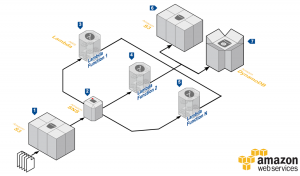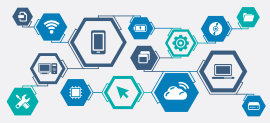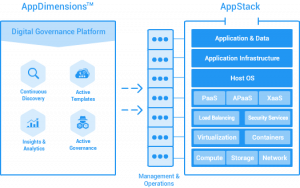Customers in 2017 will demand solutions to claim back today’s massive CAPEX and OPEX waste of over 50% of their total IT spend. All our 2017 predictions are directly derived from the rapidly increasing pressure to reclaim these resources and leverage them to achieve direct business advantages in today’s highly competitive and fast moving marketplace.
Decreasing OPEX: 30% of resources in enterprise IT are entirely unused or do not contribute to any business objectives. Additionally, resources that do have a business purpose are often vastly oversized. Identifying and reallocating this free capacity – hardware, software, management, datacenter resources – is high on the list of 2017 priorities.
Redefining the App: The definition of “application” will evolve from a monolithic entity to a logical layer that temporarily ties together microservices and functions available via APIs or event-driven actions. Apps and microservices will be created, revised and destroyed based on rapidly and continuously changing business requirements.
Service-centric & serverless computing: Deploying, monitoring and managing IT infrastructure will be vastly offloaded to mega clouds and managed service providers. Customers will design new applications to consume cloud services – database, machine learning, message bus, DNS, CDN, messaging, batch processing, analytics, artificial intelligence, workflows, data streaming, etc. – within a utility model.
 Amazon Lambda runs code without the need to provision infrastructure
Amazon Lambda runs code without the need to provision infrastructure
Serverless computing eliminates the need to worry about infrastructure management. For example, the change of a database record can automatically trigger a remote function that initiates the creation of an online payment form and invoice for Customer A. Successful credit card payment via this form triggers the automated generation of a download link and software serial number. The availability of these two components that are specific to Customer A triggers two additional functions: One to send out a confirmation email and then another one to add the link and serial to Customer A’s online account. Architects do not have to worry about defining the infrastructure required to run these functions in a scalable, highly available, secure and well performing manner.
Webscale computing: While OpenStack retains its “walking dead” status, scale out infrastructure, also referred to as webscale computing, will catch on and show significant growth in 2017. This is due to the immense pressure exercised by Amazon’s and Microsoft’s public cloud offerings. Vendors who aim to offer hardware and software for on-premise application and service deployments must respond by designing frictionless scale out and scale back capabilities.
Container management: IT organizations will embrace containers and adopt deployment, monitoring and management solutions that lower cost and risk. Today’s IT operations staff must quickly ramp up their container skills, while at the same time still managing all their traditional enterprise environments.
Hybrid cloud governance: The challenge for enterprise IT will be to recapture the workloads that were “lost” to AWS and Azure. Recapture, in this context, does not mean to bring applications back to the data center, but to introduce a central governance and policy layer that harnesses speed, agility, scalability and cost advantages of public cloud, while enforcing security, performance, availability and cost control.
Massive IoT application workloads: As devices of daily use become “intelligent,” enterprises have a key opportunity to leverage sensor and usage data to optimize user experience, lower OPEX and predict future business opportunities. On the flipside, IT infrastructure – cloud or datacenter – must absorb, analyze, process and securely store these massive amounts of data.
Accelerated move to outsourced public and private clouds: Customers will rigorously evaluate options of turning CAPEX into OPEX by simply purchasing the required infrastructure capacity through a utility model, instead of investing in more data center or cloud infrastructure capacity.
Programming becomes a critical hybrid cloud skill: The abstraction of the control plane from the actual server, network and storage infrastructure makes IT resources significantly easier to consume by software developers. In a world where infrastructure resources are defined and controlled via code, programming becomes a key skill that enables IT operations staff to effectively manage today’s hybrid enterprise infrastructure.
Single pane of glass monitoring, management and root cause analytics: With increasing heterogeneity and complexity of their environments, customers will no longer accept a siloed approach to monitoring, management and root cause analytics. There will be a strong trend toward a single point of management across the entire IT infrastructure, consisting of traditional data center infrastructure and cloud services.
A “brain” for the hybrid data center: Machine learning and artificial intelligence will be harnessed to automatically align operations management at all levels – service, app, app infrastructure, virtual environments, hosts and data center infrastructure – with today’s fast changing business goals. In a nutshell, the hybrid data center requires a “brain” to automatically optimize systems and application deployments, configurations, monitoring and management.
Final Words for 2017
2017 will be the “year of no return” where IT finally enables the business to become more competitive, by rapidly, constantly and proactively adapting to market demands. Customers in 2017 will focus on lowering OPEX to free up the resources needed to reach a much higher level of business and market responsiveness. Therefore, hardware vendors must focus on providing a software-only control plane for their systems that easily integrates with public clouds, containers and even competing hardware offerings. In short, we are at the dawn of a new age of utility computing, where the good old mainframe principles from the 1970s are applied to today’s massively heterogeneous environments.







